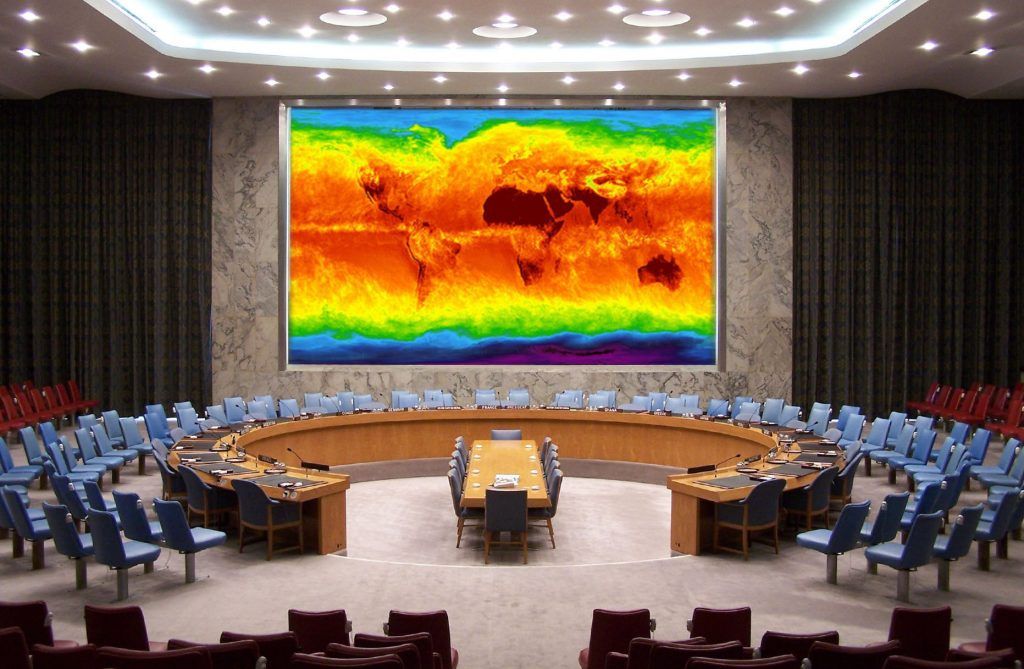What are the climate change consequences of the midterm elections?
By Dana Nuccitelli | November 9, 2018
 Security council and climate change. Illustration courtesy bwats2 and AIRS
Security council and climate change. Illustration courtesy bwats2 and AIRS
Over the past two years, the Trump administration, aided by the Republican-controlled Congress, has eroded the Obama administration’s policy efforts to curb global warming. Climate activists had hoped to reverse some of those losses in this year’s midterm elections, but the results were a mixed bag. Here is the rundown of where we stand.
What can House Democrats do with the majority? The Democrats won control of the House of Representatives and will hold about 229 seats (53 percent) starting in 2019. This gives them control over legislation in that chamber of Congress. Democrats will become House committee chairs, who choose the bills that receive a hearing and a vote in a given committee. Democrats will also be able to choose the Speaker of the House – likely to be Nancy Pelosi – who decides what bills come to the floor for a vote after they’ve passed out of committees.
We’re thus in a similar scenario as in 2009, when House Democrats led by Nancy Pelosi passed the American Clean Energy and Security Act carbon cap and trade bill. At that time, Democrats had a majority in the Senate, but not a 60-vote supermajority. Because the bill lacked the votes to defeat a Republican filibuster, it was never brought to the Senate floor for a vote. Republicans now hold the Senate and White House, so climate legislation has no chance of passing until either Democrats take control of those branches (and overcome a Senate filibuster), or a significant number of Republican lawmakers stop denying the need to address the existential threat posed by climate change.
In the meantime, Democrats can now play a major role in setting the federal budget, which means they can protect funding for climate science research and for federal agencies like the EPA. So, we can at least keep learning about the dangers posed by climate change as the Trump administration tries to increase the carbon pollution that’s creating those threats. The House Science Committee will now be controlled by Democrats rather than some of Congress’ worst science-denying Republicans like Lamar Smith (retired) and Dana Rohrabacher (defeated), and thus will thankfully no longer hold theatrical hearings to deny basic climate science.
Democratic governors can play a big climate role. Democratic candidates gained seven governorships and will now lead 23 states representing 173 million Americans (53.5 percent of the population). Given the federal government’s inability to pass climate legislation, states are playing an increasingly important role. Governor Jerry Brown has made California a world leader in implementing policies to meet the Paris climate targets.
Consider North Carolina, whose Republican governor in 2012 signed a bill blocking state agencies from considering climate science research in coastal sea level rise projections. He was replaced by Democratic governor Roy Cooper in 2017, who signed an executive order calling on the state to meet the Paris climate targets. Or New Jersey Democratic Governor Phil Murphy, who reversed Chris Christie’s decision to withdraw from the regional carbon cap and trade system. Or consider Virginia Democratic Governor Ralph Northam, who has pledged to join the cap and trade system.
In the midterm elections, Michigan, Maine, Colorado, Nevada, New Mexico, and Illinois elected governors who have endorsed 50 percent renewable energy standards or higher. We can now expect to see more states take up the climate leadership role abandoned by the Trump administration.
Oil industry spending killed several green ballot initiatives. Washington voters rejected the state’s second carbon tax proposition in the past two elections, after the oil industry spent $30 million on ads to defeat it. However, Democratic Governor Jay Inslee is determined to implement climate legislation in Washington.
In Colorado, the oil and gas industry spent nearly $40 million to defeat an anti-fracking amendment, and was successful. In Arizona, the state’s biggest utility spent $30 million to defeat a proposition to require the state to obtain 50 percent of its electricity from renewable sources.
But there was also some good news for climate advocates in the ballot initiatives. Californians voted to keep the state’s gas tax. Floridians passed a measure to ban offshore drilling. And Nevadans approved an amendment requiring electric utilities to acquire 50 percent of their electricity from renewable resources by 2030.
Climate Solutions Caucus shrinks. The Climate Solutions Caucus was a bipartisan group of 45 Republicans and 45 Democrats whose goal was to explore climate policy solutions. However, the Caucus was heavily criticized for its lack of action, and its members were labeled ‘Climate Peacocks.’ For example, in a purely symbolic vote, only four of the Republican Caucus members voted against condemning carbon taxes. Republican leader Carlos Curbelo introduced a carbon tax bill of his own, but only two fellow Republican Caucus members were willing to co-sponsor it.
It was a rough night for Republican Climate Solutions Caucus members. Curbelo lost his election, along with a dozen of his cohorts. Eight more Republican members retired from Congress. That leaves about 24 of the 45 Caucus conservatives in office starting in 2019, having lost their leader.
This was an expected outcome – the moderate Republicans who are more likely to be relatively realistic about climate change also tended to be the most vulnerable in a wave election. Democrats can now control the legislative agenda in the House, but there are fewer moderate Republicans left in office who might work with them on climate bills. On the one hand, that means climate legislation won’t be watered down by compromise; on the other hand, even fewer Republicans will sign on.
Climate change will regrettably remain a politically polarized issue in America until at least 2021. But Democrats gained the critically important control of the House and its committees, and even more importantly, of a number of state governorships. Over the next two years, it will be up to the individual states to advance the climate agenda by accelerating the transition away from fossil fuels.
Together, we make the world safer.
The Bulletin elevates expert voices above the noise. But as an independent nonprofit organization, our operations depend on the support of readers like you. Help us continue to deliver quality journalism that holds leaders accountable. Your support of our work at any level is important. In return, we promise our coverage will be understandable, influential, vigilant, solution-oriented, and fair-minded. Together we can make a difference.
Keywords: US climate policy, climate change, climate legislation, midterm elections
Topics: Climate Change, Special Topics
















The obvious fallacy of this article is the assumption that Democratic Congresspeople are sure to support action to counter the climate crisis.